So, What's the Plan?
Does your business have a plan in place for when top leadership retires? What about if they decide to quit and leave the company altogether? In today's competitive job market, it is especially critical that businesses have a plan in place so that business continues to run smoothly.
What is Succession Planning?
Succession planning refers to the intentional process of identifying future successors to critical roles in an organization, such as when the current employee in that position is promoted, retires, or decides to leave the company. Succession planning ensures that your business can continue running smoothly after a key role becomes vacant.
You may have heard of succession planning, but did you know that it can take anywhere from 12 months to 3 years of planning, depending on the seniority if the role, for the successor to be fully prepared to move into their new position? Let’s look quickly at Apple – when you think of Apple, Steve Jobs is usually the first person to come to mind. It is an unfortunate example, but one that occurs too often in everyday life. When Jobs became sick and stepped down, Apple seamlessly transitioned Tim Cook into the role of CEO. They were successful because they had been preparing him for years prior to Jobs’ departure. They also established Apple University to train and educate many more candidates for years to come, building a talent pipeline of qualified candidates to promote from within, ones who already know the ins and outs of the business.
Why is it Important?
There are several benefits to succession planning, including:
Maintaining the organization’s brand integrity.
Revealing vulnerabilities and highlighting skill gaps.
Promoting organizational training/development, and employee engagement.
Knowledge transfer and process refinement.
One of the greatest benefits is that it protects the organization from any sudden or unexpected changes. Much like the Apple example, life is unexpected, and no one can predict the future.
It is important to establish a proactive plan, rather than a reactive plan. Reactive succession happens when an organization does not have a backup plan for someone leaving a key role, causing them to scramble for a new hire or internal promotion, sometimes leading to poor decisions of a replacement. Being proactive in planning means giving careful thought, consideration, and using strategy to plan ahead of time for one's departure.
By identifying an internal successor, businesses can ensure that they will continue to be led by someone who shares the organization's missions and values as well as having prior knowledge of and experience building relationships with clients and employees.
How Does it Work?
Although succession planning varies from organization to organization, certain fundamentals remain the same. To begin the process, you need to gain the support of key stakeholders, including the CEO, Executive Director, or other top management personnel. Collectively you will assess the critical positions in which you are planning for. Once the roles have been identified, it is time to identify high-potential employees for these key roles, and the extent to which your internal candidates can fill these positions. It is important to develop a professional development plan that supports the succession strategy and to continuously check-in, monitor, and evaluate the progress and succession strategy.
This can be broken down into 6 keys steps:
Identify key positions.
Build success profiles.
Identify interested succession candidates.
Review the readiness of succession candidates.
Create a personal development plan.
Track and evaluate progress.
Want More Information?
Our Succession Planning Guidebook walks you through the 6 key steps for successful succession planning and includes templates for tracking and evaluating progress. Contact us for more information, consultation, and to receive a discounted copy of our guide (use code Blog15).









